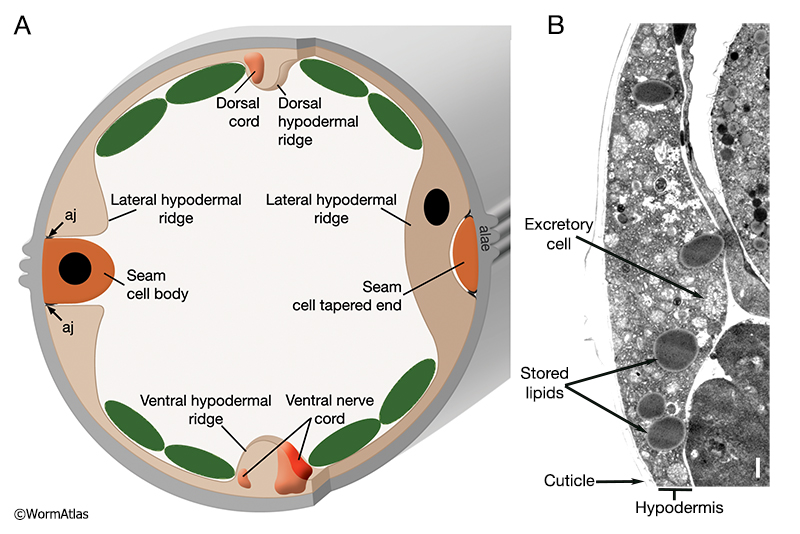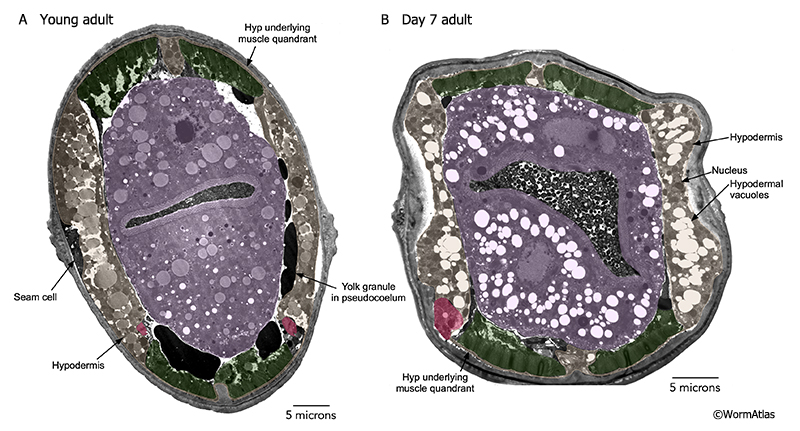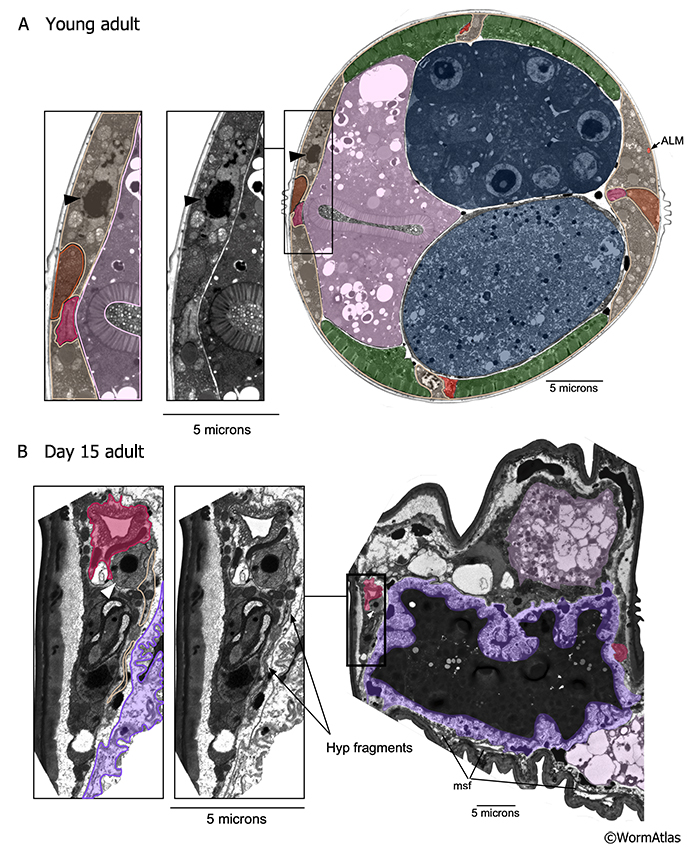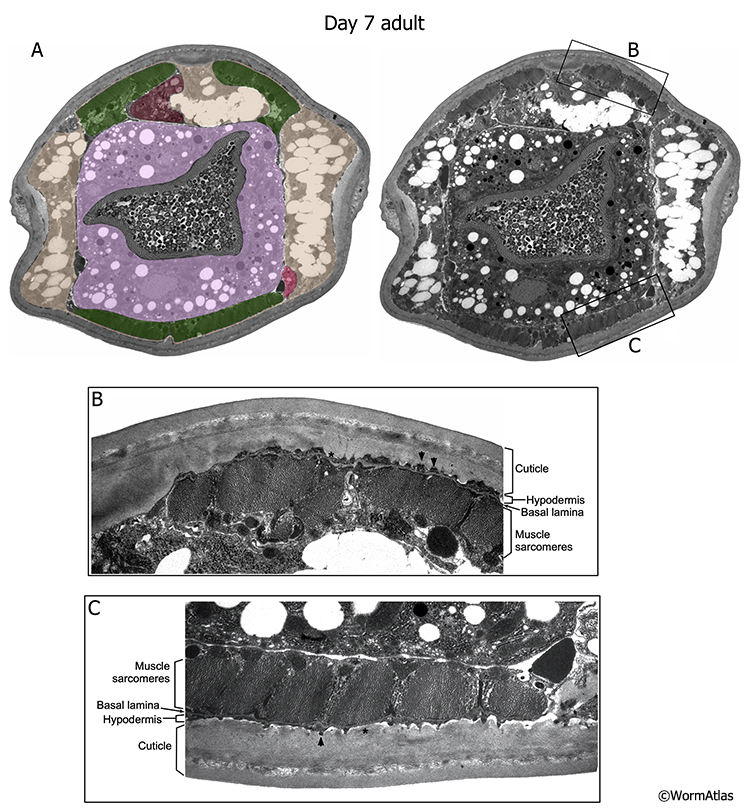1 General Description
The C. elegans hypodermis encircles the body from head to tail with openings for the buccal cavity, excretory canal, the vulva and the anus. Large sections of the hypodermis are multinucleate syncytia that form during embryogenesis and larval stages. Other regions have single hypodermal cells abutting to completely enclose the pseudocoelom, particularly in the head and tail regions. Seen in cross section, the hypodermis also forms a thin sheet between the four body wall muscle quadrants and the body cuticle, where it serves to anchor the muscle cells to the cuticle (AHypFIG 1, also CutFIG 1A & MusFIG 11). In between the body wall muscle quadrants, the hypodermis expands to occupy larger volumes, the "hypodermal cords" providing space for the cell nuclei and most other cytoplasmic components (see Hermaphrodite Cuticle and Hermaphrodite Hypodermis for more detail).
 AHypFIG 1: Structure of the hypodermis and surrounding tissues. A. Schematic showing the interactive structure of the hypodermis with the body wall muscles, seam cells and the cuticle. The hypodermis is composed of four major longitudinal ridges (ventral, dorsal, and left/right lateral) that are joined circumferentially by thin sheets of cytoplasm. At each original cell body of the seam syncytium, where the nuclei are positioned, the seam completely interrupts hyp 7, whereas at the ends of the cells, the seam is so thin that hyp 7 runs behind it, enfolding it completely. At its apical surface, seam makes adherens junctions (aj) to the hypodermis throughout its length. (Green ovals) Muscle quadrants. B. TEM, transverse section representing an area through the hypodermis in an adult animal. Seam cell is tapered down here and not easily seen. Bar, 1µm. (Image source: [Hall] N506 M700.) (See also Hermaphrodite Hypodermis and Hermaphrodite Seam Cells for more details.)
The hypodermis carries out several roles during the larval and adult stages. During development, the hypodermis guides body plan specification and produces the components of the basement membrane and cuticle. Through the basement membrane, the hypodermis anchors the body muscle cells to the rigid cuticle. As growth proceeds during larval stages and in the young adult, the hypodermal syncytium must continue to expand to enclose and protect the animal's internal structures. Finally, the hypodermis contributes to internal homeostasis by engulfment of damaged cells, organelles and other materials from the pseudocoelom (Zhang et al., 2015, Nichols et al, 2016).
In young adults, the hypodermis serves as a collection basket for excess material in the pseudocoelom, presumably taking up this material via endocytosis. The storage of excess yolk here was first found by Kimble and Sharrock (1983) and by Hall et al. (1999). Similarly, hypodermis appears as the major storage locale for excess glycogen deposits in young adult animals that underwent starvation during early development, apparently as an epigenetic compensation for that earlier starvation (Hall, unpublished). In neither case is the material degraded, as far as one can tell, but stored for later use by the animal. This mechanism is in parallel to the degradation pathways offered by the coelomocytes (Fares and Greenwald, 2001; Tahseen, 2009).
Another role for hypodermis in degradation of damaged cells and organelles has more recently been noted in the exopher pathway (Melentijevic et al., 2017). This instance is more complicated, with damaged neuronal organelles and cytoplasm being jettisoned from the neuron soma into a large degradative package, the exopher, which enters the hypodermis for further destruction prior to a mop-up action by the coelomocyte. There is accumulating evidence for autophagy as a major factor in hypodermal processing of the exopher (Melentijevic et al., 2017; Driscoll, unpublished). The hypodermis may play similar roles in both storage of other materials (besides yolk and glycogen), and destruction of damaged organelles in parallel to the action of the coelomocytes (see Hermaphrodite Coelomocyte for more detail.)
2 Aging of the Hypodermis
As the animal ages (for an overview, see Aging Introduction), these earlier roles of the adult hypodermis may become difficult to maintain as the tissue itself shrinks in volume and loses the ability to produce new RNA transcripts or new proteins related to such tasks. However, autophagy may provide a mechanism for tissue shrinkage and production of vacuoles in the aging hypodermis, not unlike how dauer tissues and seam cells shrink during earlier stages of development (Meléndez et al., 2003).
In general, aging causes progressive hypodermal degeneration and loss of function. For example, hypodermal cells from older adults display lower levels of gene expression (Budovskaya et al., 2008). Consistently, nuclear architecture progressively deteriorates with aging in C. elegans hypodermal cells, as in muscle and intestinal cells (Haithcock et al., 2005). Viewed by TEM, the hypodermal cytoplasm loses much of its normal contents and becomes progressively less electron dense. Mitochondria as well as smooth and rough endoplasmic reticulum (SER, RER) appear lost or damaged. Certain hypodermal nuclei completely disappear, as noted for three hypodermal nuclei in the hermaphrodite tail (Golden et al., 2007).
In 7-day old adults, the hypodermis is usually identifiable but intracellular contents may be disorganized or take on a vacuolar appearance (AHypFIG 2 & AHypFIG 3). At older ages, the hypodermal cylinder becomes exceedingly thin in all portions, as other internal organs swell, and the hypodermis becomes distorted and loses its shape. By the time animals reach adult day 15, the delicate hypodermal cells may be completely absent except for shredded remnants (AHypFIG 4). This may reflect the lack of structural components in hypodermal cells. This feature may make these cells more sensitive to changes in osmotic or shear stress in later ages. At late stages the hypodermal tissue thins to the breaking point, with an almost empty cytoplasm and apparent weakened plasma membranes - particularly weak on the basal pole facing the pseudocoelom (AHypFIG 4).
AHypFIG 2: Vacuoles in the head hypodermal cells of older adult. A. Cross-section of the head region in a young adult with the hypodermal cells indicated with tan shading. In the head, hypodermal cells are not all syncytial. Excretory cell ec (magenta); muscle m (green); Bar, 5 µm. B. In this day 7 adult, the hypodermal cells (tan) in the head region have accumulated large numbers of vacuoles but retain the same approximate body volume as in the young adult. Overall diameter of the body is now larger, and the body is also longer, so total body volume is increased. Neither seam cell is now evident, possibly due to similar changes inside that tissue, or due to the distortions of the lateral hypodermis by vacuolation. There also appears to be some separation of the hypodermis from the cuticle attachments along several regions of the body, but muscles (green) still seem well anchored to the cuticle. Asterisks indicate image artefacts not indicative of body morphology. Bar, 5 µm. (Image sources: A. N510C V782 [D. Hall]; B. N825 G4168 [D. Hall].)


In many older adult C. elegans, the body takes on a swollen appearance, possibly suggesting increasing osmotic stress due to a leaky and structurally weaker cuticle (see Hermaphrodite Cuticle and Aging Cuticle). The hypodermis may be one cell type highly susceptible to stresses resulting from loss of cuticle integrity during aging. Compared to most other tissues, the hypodermis appears to be a weak link, and its physical breakdown may have fatal consequences. If the hypodermal cylinder is abrogated, pseudocoelom may mix with apical contents, anchorages between body wall muscles and the cuticle might weaken, leaving remaining cells floating inside a bare cuticle. However, the onset of hypodermal degeneration seems to be highly localized within the body. As an example, the hypodermal structures beneath the body muscle sarcomeres showed localized thinning despite preservation of the anchoring intermediate filament structures pinning the body muscle to the cuticle (Herndon et al., 2002; Herndon et al., 2017) (AHypFIG 5). This data suggests that localized breakdown of the hypodermis leads to progressive deterioration as aging continues.

|
3 References
Budovskaya, Y.V., Wu, K., Southworth, L.K., Jiang, M., Tedesco, P., Johnson, T.E. and Kim, S.K. 2008. An elt-3/elt-5/elt-6 GATA transcription circuit guides aging in C. elegans. Cell 134: 291-303.
Fares, H. and Greenwald, I. 2001. Genetic analysis of endocytosis in Caenorhabditis elegans : coelomocyte uptake defective mutants. Genetics 159:133-145. Article
Golden, T.R., Beckman, K.B., Lee, A.H.J., Dudek, N., Hubbard, A., Samper, E. and Melov, S. 2007. Dramatic age-related changes in nuclear and genome copy number in the nematode Caenorhabditis elegans. Aging Cell 6:179-188. Article
Haithcock, E., Dayani, Y., Neufeld, E., Zahand, A.J., Feinstein, N., Mattout, A., Gruenbaum, Y. and Liu, J. 2005. Age-related changes of nuclear architecture in Caenorhabditis elegans. PNAS 102: 16690-16695.
Hall, D.H., Winfrey, V.P., Blauer, G., Hoffman, L., Furuta, T., Rose, K.L., Hobert, O. and Greenstein, D. 1999. Ultrastructural features of the adult hermaphrodite gonad of C. elegans: Relations between the germ line and soma. Dev. Biol. 212: 101-123. Article
Herndon, L.A., Schmeissner, P.J., Dudaronek, J.M., Brown, P.A., Listner, K.M., Sakano, Y., Paupard, M.C., Hall, D.H. and Driscoll, M. 2002. Stochastic and genetic factors influence tissue-specific decline in ageing C. elegans. Nature 419: 808-814. Article
Herndon, L.A., Wolkow, C.A., Driscoll, M. and Hall, D.H. 2017. Effects of ageing on the basic biology and anatomy of C. elegans. In Ageing: lessons from C. elegans. (ed Olsen, A. and Gill, M.). Chapter 2. pp. 9-39. Springer International, Switzerland. Article
Kimble, J. and Sharrock, W. J. 1983. Tissue-specific synthesis of yolk proteins in Caenorhabditis elegans. Dev. Biol. 9: 189-196. Abstract
Meléndez, A., Tallóczy, Z., Seaman, M., Eskelinen, E L., Hall, D H., and Levine, B. 2003. Autophagy genes are essential for dauer development and life-span extension in C. elegans. Science 301: 1387-1391. Abstract
Melentijevic, I., Toth, M.L., Arnold, M.L., Guasp, R.J., Harinath, G., Nguyen, K.C., Taub, D., Parker, J.A., Neri, C., Gabel, C.V., Hall, D.H. and Driscoll, M. 2017. C. elegans neurons jettison protein aggregates and mitochondria under neurotoxic stress. Nature 542: 367-71. Abstract
Nichols, A.L., Meelkop, E., Linton, C., Giordano-Santini, R., Sullivan, R.K., Donato, A., Nolan, C., Hall, D.H., Xue, D., Neumann, B. and Hilliard, M.A. 2016. The apoptotic engulfment machinery regulates axonal degeneration in C. elegans neurons. Cell Rep. 14: 1673-83. doi: 10.1016/j.celrep.2016.01.050. Article
Tahseen, Q. 2009. Coelomocytes: Biology and possible immune functions in invertebrates with special remarks on nematodes. Int. J. Zool. DOI: 10.1155/2009/218197 Article
Zhang, H, Chang, J.T., Guo, B., Hansen, M., Jia, K., Kovacs, A.L., Kumsta, C., Lapierre, L.R., Legouis, R., Lin, L., Lu, Q., Meléndez, A., O'Rourke, E.J., Sato, K., Sato, M., Wang, X. and Wu,F. 2015. Guidelines for monitoring autophagy in Caenorhabditis elegans. Autophagy 11: 9-27.
* Description of Behavioral Classes (A, B, C) as described in Herndon et al., 2002
To characterize aging phenotypes, age-synchronized individual worms were scored both for spontaneous movement and for response to prodding with a wire over the course of their lifespan. Three distinct classes representing behavioral phenotypes were established. Animals that move constantly and make sinusoidal tracks were designated as class A. Class B animals mainly move when prodded. When they move it is with uncoordinated motion, leaving non-sinusoidal tracks. Class C animals do not move forward or backward, even upon prodding, but do show head and/or tail movement and twitch in response to touch. All animals begin adulthood in class A. Class B animals appear around days 6-7 of adulthood and class C around day 9-10 (at 20oC). At later ages, animals representing all classes can be found within the same population and it was found that the behavioral class type was the better predictor of life expectancy than chronological age (Herndon et al., 2002). Due to the stochastic nature of aging in an individual nematode, these classifications only reflect ongoing changes in nerve and muscle, while other tissues can show very different age-related effects within one behavioral class, declining faster or remaining healthy much longer.
|